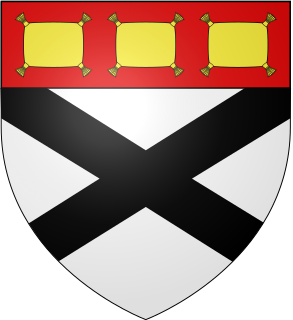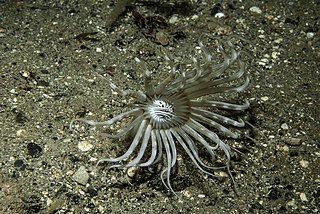
Earl of Annandale and Hartfell is a title in the Peerage of Scotland, created in 1661 for James Johnstone.

The Mastigoteuthidae, also known as whip-lash squid, are a family of small deep-sea squid. Approximately 20 known species in six genera are represented, with members found in both the mesopelagic and bathypelagic zone of most oceans. Originally described by Verill in 1881, it was later lowered by Chun (1920) to a subfamily (Mastigoteuthinae) of the Chiroteuthidae. However, Roper et al. (1969) raised it back to the family level, and this has not been changed since. The taxonomy of this family is extremely unstable, and there have been at times one genus, two genera and four subgenera(Salcedo-Vargas & Okutani, 1994), two genera and several 'groups', five genera and one species with an uncertain placement, or six genera.

Tube-dwelling anemones or ceriantharians look very similar to sea anemones but belong to an entirely different subclass of anthozoans. They are solitary, living buried in soft sediments. Tube anemones live inside and can withdraw into tubes, which are composed of a fibrous material made from secreted mucus and threads of nematocyst-like organelles known as ptychocysts. Ceriantharians were formerly classified in the taxon Ceriantipatharia along with the black corals but have since been moved to their own subclass, Ceriantharia.

Octopus is the largest genus of octopuses, comprising more than 100 species. These species are widespread throughout the world's oceans. Many species formerly placed in the genus Octopus are now assigned to other genera within the family Octopodidae.

Spongilla is a genus of freshwater sponges in the family Spongillidae found in lakes and slow streams. Sponges of the genus Spongilla attach themselves to rocks and logs and filter the water for various small aquatic organisms such as protozoans, bacteria, and other free-floating pond life. Unlike marine sponges, freshwater sponges are exposed to far more adverse and variable environmental conditions, so they have developed gemmules as a means of dormancy. When exposed to excessively cold or otherwise harsh situations, the sponges form these gemmules, which are highly resistant "buds" that can live dormant after the mother sponge has died. When conditions improve, the gemmules "germinate" and a new sponge is born.

Bathypolypus is a genus of octopuses in the monotypic family Bathypolypodidae. It has five described species.
Annandale's rat is a species of rodent in the family Muridae. It is found in Indonesia (Sumatra), Peninsular Malaysia, and Singapore. It was classified as Rattus annandalei until 2017, but mitochondrial and nuclear DNA show that it belongs to the rat genus Sundamys.

The Nassariidae, Nassa mud snails (USA), or dog whelks (UK), are a taxonomic family of small to medium-sized sea snails, marine gastropod mollusks in the clade Neogastropoda.

Byturidae, also known as Fruitworms, is a very small family of beetles, in the suborder Polyphaga, comprising fewer than 20 species worldwide. The larvae of some species develop in fruits. Byturus unicolor affects species of Rubus and Geum.
Charles William Gee was an English international footballer, who played as a centre half.

Lepas is a genus of goose barnacles in the family Lepadidae.

Corynidae is a family of hydrozoans in the order Anthomedusae.

Metapenaeus is a genus of prawns, containing the following species:
Heteralepas is a genus of goose barnacles in the family Heteralepadidae.

Arachnactidae is a family of tube-dwelling anemones in the order Ceriantharia. It is the only family in the monotypic order Penicillaria and comprises around 38 species. They differ from other ceriantharians in the makeup of their cnidome, the relative sizes of the oral discs and the shape and structure of the mesenteries. These tube anemones dwell in parchment-like tubes immersed in soft sediment, and have two whorls of tentacles, the outer ones being much longer than the inner ones.
Poecilasmatidae is a family of goose barnacles.
Gonatopsis is a genus of squid from the family Gonatidae. They are characterised by the loss of their tentacles by the time they have reach the subadult stage. They have arms which have two series of hooks along the midline of the oral surface arms, the radula has five or seven teeth, the mantle can be muscular or flabby, fins are rhomboid or arrow shaped and they lack photophores. They are found in the North Pacific.













